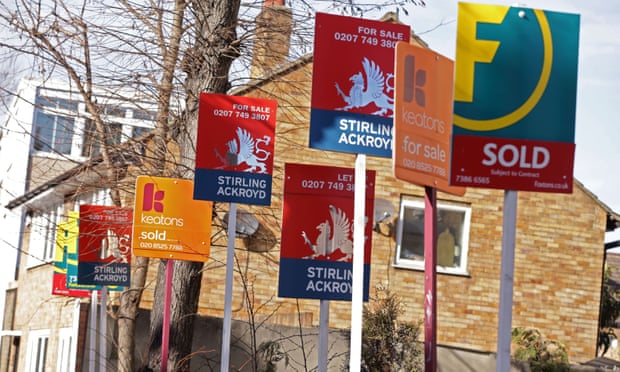UK house prices fell for the first time in almost two years in March, according to Nationwide, in the latest sign of a slowdown in the property market.
The average price of a home fell 0.3% to £207,308 following a 0.6% rise in prices in February. It was the first fall on the Nationwide index since June 2015 and surprised City economists who had forecast a 0.4% increase in prices.
The fall pushed the annual rate of growth down to a 19-month low of 3.5%, weaker than expected. And it echoed a report earlier in the week from the Bank of England, which said mortgage approvals had fallen for the first time in six months in February.
Britain’s housing market is expected to come under some pressure in 2017 as the backdrop for consumers weakens. Household finances are being squeezed by a combination of rising inflation and weak wage growth, potentially deterring people from committing to major spending decisions.
However, economists believe a housing crash is unlikely because a shortage of homes coming on to the market in the UK will limit the extent to which prices fall.
“Markedly weakening consumer fundamentals, likely mounting caution over making major spending decisions, and elevated house price to earnings ratios are likely to weigh down on housing market activity and house prices,” said Howard Archer, UK chief at IHS Markit.
“However, a shortage of supply is likely to put a floor under prices. Consequently, we believe house price gains over 2017 will be limited to around 2.5%.”
Nationwide said that over the first quarter, there was the least variation in regional house price performance in almost 40 years. At 6.8 percentage points, the gap between the weakest and strongest performing regions was the lowest since 1978.
“The south of England continued to see slightly stronger price growth than the north of England, but there was a further narrowing in the differential,” said Robert Gardner, Nationwide’s chief economist.
“Northern Ireland saw a slight pickup in annual house price growth, while conditions remained relatively subdued in Scotland and Wales.”
Looking at trends over the past decade, the mortgage lender said home ownership in England was at the lowest level since 1985, at 62.9% in 2016. Ownership rates among those aged 35-44 fell sharply to 56% from 74% in 2006.
“The counterpart to this trend has been robust growth in the private rental sector, with 20% of households in England now privately rented, a record high, up from 12% 10 years ago,” Gardner said.
Brian Murphy, head of lending at the Mortgage Advice Bureau, said a cooling of the UK housing market might enable more people to get on to the housing ladder.
“In itself, this wouldn’t perhaps be a negative trend, as a slowing down of prices coupled with the ongoing near record low mortgage rates available may provide a welcome opportunity for those who want to get on to or move up the property ladder to take advantage of the current climate.
“Given that … home ownership levels are at their lowest since the mid-80s, then any market conditions which may assist more people to buy their own property could be seen as a positive development, rather than a cause for concern.”


